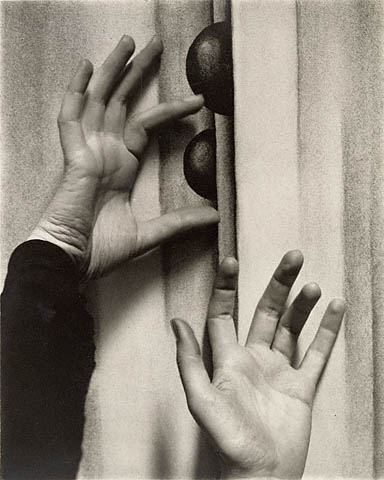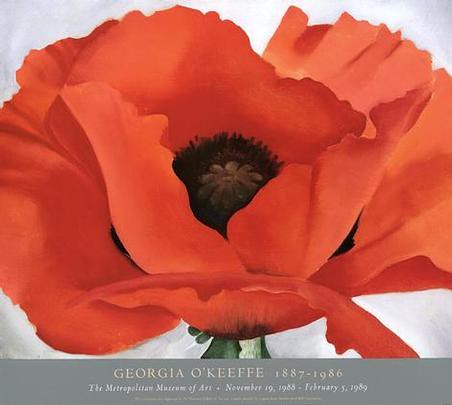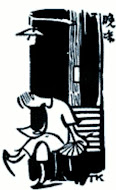
American, New York City, 1919
The camera always stood near the wall-a box maybe a foot square and four or five inches thick. It stood on its rickety tripod with the black head cloth over it-a bit worn with much use-maybe a bulb hanging down on a small rubber cord. Beside the camera was folded a dirty white umbrella that was a large white circle when opened. ... These things were always around nearby so he could grab them...
-Georgia O'Keeffe
Georgia O'Keeffe and Alfred Stieglitz shared a New York City apartment where he likely made this photograph of her. Many of his early portraits of O'Keeffe-like this one made two years after they became a couple-reflect their passion for each other. Stieglitz launched O'Keeffe's career by exhibiting her paintings and drawings at his New York gallery, 291. Eventually they married, and he continued making portraits of her throughout their lives together.
This image displays a degree of eroticism as O'Keeffe's hands-with palms facing the camera-look as if they are about to squeeze a round shape in her Drawing No. 17 . This "portrait" of O'Keeffe was considered highly unconventional at the time. It is like others in the series, most of which are close-ups of her body, often with one of her abstract works of art serving as a background. The figure and background seem to blend seamlessly, forming an image that borders on abstraction.

This photograph, one of more than three hundred images Stieglitz made of O'Keeffe (1887-1986) between 1917 and 1937, is part of an extraordinary composite portrait. Stieglitz believed that portraiture concerned more than merely the face and that it should be a record of a person's entire experience, a mosaic of expressive movements, emotions, and gestures that would function collectively to evoke a life. "To demand the portrait that will be a complete portrait of any person," he claimed, "is as futile as to demand that a motion picture be condensed into a single still."

Georgia O'Keeffe
The photographer Alfred Stieglitz sought to bring to America examples of the revolutionary developments of modern art in Europe and to provide support as well for progressive artists and photographers who lived and worked in the United States. His New York gallery "291" exhibited work by such artists as Picasso, Matisse, Marin, Hartley, and O'Keeffe, who would become Stieglitz's wife. He photographed her hundreds of times over the years, varying the poses and focusing on parts of her body in a totally modern approach to the portrait. In Georgia O'Keeffe,the subject seems as confident, monumental, and enigmatically beautiful as her works, one of which appears behind her.

Georgia O'Keeffe, 1920

Portrait of Georgia O'Keeffe, 1920

Georgia O'Keeffe After Return from New Mexico, 1929

Portrait - Georgia O'Keeffe 1929

Alfred Stieglitz, Georgia O'Keeffe, 1933

Georgia O'Keeffe's Hand and Wheel
Alfred Stieglitz (American, 1864 - 1946)
Between 1917 and 1937, Stieglitz made hundreds of portraits of his wife, painter Georgia O'Keeffe. Endeavoring to capture her unique personality and physical presence, Stieglitz found that the essence of O'Keeffe was expressed not only in her face but also in close-up studies of parts of her body---especially her hands. In 1933, O'Keeffe was completing a long recovery from a nervous breakdown she suffered late in 1932. She was overjoyed to be reunited with her Ford V-8 convertible---a potent symbol of her personal freedom. To convey O'Keeffe's affection for the vehicle, Stieglitz used the motif of her hand caressing the gleaming cover of the car's spare tire.

Georgia O'Keeffe
Alfred Stieglitz (American, 1864 - 1946)
One of the most important photographers of the 20th century, Stieglitz made hundreds of pictures of his wife, painter Georgia O'Keeffe (1887-1986), recording her physical and psychological evolution from 1917 to 1937. This image was taken at Lake George, where O'Keeffe was completing a long recovery from an emotional breakdown she suffered the previous year. To convey her affection for her Ford V-8 convertible-a potent symbol of her personal freedom-Stieglitz posed her leaning against the shiny spare tire cover on the back of the auto, highlighting her arms and hands. Despite her joy at being united with the vehicle, the darkly toned portrait captures O'Keeffe's lifeless, distant eyes and somber face, revealing her prevailing despondency.
-----------------------
把这些搜到的照片放到一起,才感觉真是伟大,无论是Stieglitz,还是O'Keeffe,都太出色了。
Stieglitz is so great, after I put all photos together.
O'Keeffe is such a vivid image in his lens. At the same time, she herself is so brilliant...
评论人:乱看 评论日期:2004-12-11 22:29
there is not much i can add to this... but, then, that is not necessary at all!
many regards, sebastian
评论人:dropin 评论日期:2004-12-12 23:42
I understand why Stieglitz focused on her hands although I can't put it in words properly ... when I was eleven years old I had an accident and something in my left hand broke. For some years it was aching, and still today I have a small bump on the back of my hand. Fortunately I can use it without problems. But I got aware of how important my hands are for expressing myself.
I got curious about Georgia o'Keeffe now, and found this website:
O'Keeffe
She said about her very large flower paintings:
"Most people in the city rush around so, they have no time to look at a flower. I want them to see it whether they want to or not."
Interesting idea.
Denise
评论人:dropin 评论日期:2004-12-16 22:12
I agree hands are important.
I also got my left wrist hurt in universtisy. It's packed in plaster. And at that time I am in a project. So the first time, I realized, well, I can't work without a hand...
This sounds funny, sure cant. But I never realized that. I always thought, well, a pianist can't live without hands. But for me... I am nothing to do with a pianist...
Well, in some degree, I share something with a pianist: we all live on keyboads. :) That's a nice connection.
So, I took Stieglitz's focus in this way instinctively: well, O'Keeffe is a painter, that's another kind of people living on hands.
Em, actually a lot of people living on hands. It's not the full reason. At the same time, her hands is nice and expressive and so on... :)
About her big flowers, there is another insteresting line on a memorizing stamp sets of her red poppy, 1927

'Nobody sees a flower, really - it's so small - We haven't time, and to see takes time, like to have a friend takes time.'
Goregia O'Keeffe
评论人:乱看 评论日期:2004-12-19 12:32
this is sebastian
finally i found some words (although i still think the pictures (both stieglitz' photos and o'keefe's paintings) speak for themselves).
hands are very expressive.
they "talk" in a way people barely can control. people are used to care for their words - they won't say something they want to keep secret - but in most cases hands still talk the truth.
and because hands are so well developed to do almost everything, they have also the power to express. so, it is no surprize, that as soon as you take care of hands, when doing portraits, the results (the protraits) gain a lot in quality.
and stieglitz did a brilliant job!
评论人:dropin 评论日期:2004-12-19 22:22






No comments:
Post a Comment